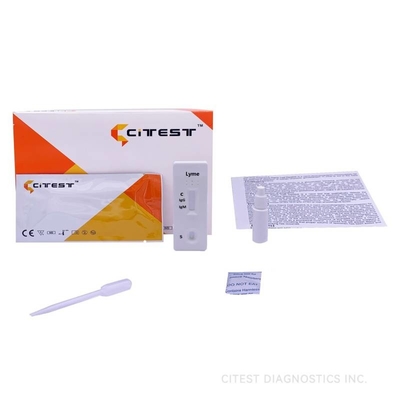

| Product features | Parameters |
| Principle | Chromatographic Immunoassay |
| Format | Cassette |
| Specimen | WB/S/P |
| Certificate | CE |
| Reading Time | 10 minutes |
| Pack | 10 T |
| Storage Temperature | 2-30°C |
| Shelf Life | 2 Years |
Applications:
The Lyme IgG/IgM Rapid Test Cassette is a lateral flow chromatographic immunoassay for the qualitative detection of IgG and IgM antibodies to Borrelia in human whole blood, serum or plasma specimen.
Description:
Lyme disease, also known as Lyme borreliosis, is an infectious disease caused by bacteria of the Borrelia sp. which is spread by ticks. The most common sign of infection is an expanding area of redness on the skin, known as erythema migrans, that begins at the site of a tick bite about a week after it has occurred. The rash is typically neither itchy nor painful.
Approximately 25–50% of infected people do not develop a rash. Other early symptoms may include fever, headache and feeling tired. If untreated, symptoms may include loss of the ability to move one or both sides of the face, joint pains, severe headaches with neck stiffness, or heart palpitations, among others. 1 Months to years later, repeated episodes of joint pain and swelling may occur.
Occasionally, people develop shooting pains or tingling in their arms and legs. 1 Despite appropriate treatment, about 10 to 20% of people develop joint pains, memory problems, and feel tired for at least six months. Lyme disease is transmitted to humans by the bite of infected ticks of the genus Ixodes. Usually, the tick must be attached for 36 to 48 hours before the bacteria can spread. 6 In North America, Borrelia burgdorferi and Borrelia mayonii are the causes. In Europe and Asia, the bacteria Borrelia afzelii and Borrelia garinii are also causes of the disease.
The disease does not appear to be transmissible between people, by other animals, or through food.Diagnosis is based upon a combination of symptoms, history of tick exposure, and possibly testing for specific antibodies in the blood. Blood tests are often negative in the early stages of the disease. 2 Testing of individual ticks is not typically useful.
How to use?
INTERPRETATION OF RESULTS
(Please refer to the illustration above)
IgG POSITIVE:* Two colored lines appear. One colored line should always appear in the control line region (C) and another line should be in the IgG line region.
IgM POSITIVE:* Two colored lines appear. One colored line should always appear in the control line region (C) and another line should be in the IgM line region.
IgG and IgM POSITIVE:* Three colored lines appear. One colored line should always appear in the control line region (C) and two test lines should be in the IgG line region and IgM line region.
*NOTE: The intensity of the color in the test line regions may vary depending on the concentration of anti-Lyme antibodies present in the specimen. Therefore, any shade of color in the test line region should be considered positive.
NEGATIVE: One colored line appears in the control line region (C). No line appears in the IgG region or the IgM region.
INVALID: Control line fails to appear. Insufficient specimen volume or incorrect procedural techniques are the most likely reasons for control line failure. Review the procedure and repeat the test with a new test. If the problem persists, discontinue using the test kit immediately and contact your local distributor.
Order Information
| Cat. No. | Product Description | Specimen | Format | Kit Size | Cut-Off | Status |
| ILY-402 | Lyme IgG/IgM Rapid Test Cassette | WB/S/P | Cassette | 10 T | See Insert | CE |